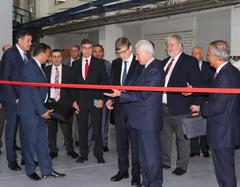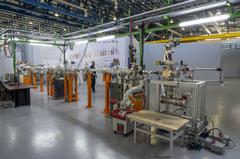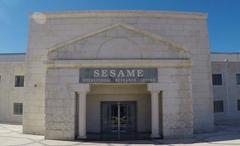URL: https://www.desy.de/news/news_search/index_eng.html
Breadcrumb Navigation
DESY News: Inauguration of the Helmholtz Experimental Station at the X-ray source SESAME in Jordan
News
News from the DESY research centre
Inauguration of the Helmholtz Experimental Station at the X-ray source SESAME in Jordan
A new experimental station has been opened at the SESAME X-ray source in Jordan: The Helmholtz-SESAME Beamline (HESEB) had been designed by five research centers of the Helmholtz Association under the leadership of DESY and considerably extends the experimental possibilities of the facility. It will make so-called soft X-ray light available for research at SESAME, which has less energy than hard X-rays. The project involves Forschungszentrum Jülich, Helmholtz-Zentrum Berlin, Helmholtz-Zentrum Dresden-Rossendorf, Karlsruhe Institute of Technology and DESY.

The synchrotron radiation source SESAME in Jordan opened its doors in 2017 and is the only facility of its kind in the Middle East. Credit: SESAME
„With the HESEB inauguration, SESAME will gain even more charisma and attractiveness in the region,“ emphasized Helmut Dosch, Chairman of the DESY Board of Directora, representing the HESEB consortium. „The new research opportunities promote collaboration, networking and exchange among the regional scientific communities and are thus a model of science diplomacy in action.“
The President of the Helmholtz Association, Otmar Wiestler, added: „For many years now, SESAME has been demonstrating in an impressive way how a joint research project can bring people from different countries in the Middle East together for civilian research. SESAME is a true bridge builder and a beacon of science diplomacy.“

Inauguration ceremony for HESEB in the SESAME hall. Credit: SESAME, Abedalhakim Alzubi
Together with the German Ambassador to Jordan, Bernhard Kampmann, the director of SESAME, Khaled Toukan, and the President of the SESAME Council, Rolf-Dieter Heuer, Owais, Wiestler and Dosch unveiled a commemorative plaque at the HESEB opening ceremony.
Soft X-rays offer the opportunity to study a wide range of scientific questions in solid-state, interface and surface physics, in physical chemistry, biological systems and in earth and environmental sciences. The element-specific interactions of soft X-rays with matter allow analytical spectroscopic investigation procedures with high precision for many elements of the periodic system, particularly at surfaces and interfaces. Established X-ray techniques allow numerous scientific applications, for instance in the field of energy and semiconductor materials, magnetic films or catalytic systems. There are also many applications of soft X-rays in the field of cultural heritage.

The HESEB set-up at SESAME. Credit: DESY, Edgar Weckert
SESAME went into operation in 2017 and is the only facility of its kind in the Middle East. Scientists can conduct structural studies there using X-rays - from screening new materials and examining cultural artifacts to analysing biomolecules. Since the foundation of SESAME, Germany has participated as an observer in the international SESAME Council. DESY assumes this role on behalf of the German Federal Ministry of Education and Research (BMBF).
To promote research excellence and closer networking at SESAME, the Helmholtz Association decided in 2018, on DESY's initiative, to build the state-of-the-art HESEB for the accelerator in a four-year project. The 3.5 million euro beamline and experimental station, which was funded by the Helmholtz Association, led to additional investments from the various SESAME countries. For example, Turkey approved additional funds for the construction of a second experimental station at HESEB.
Further Information:
https://heseb.desy.de




